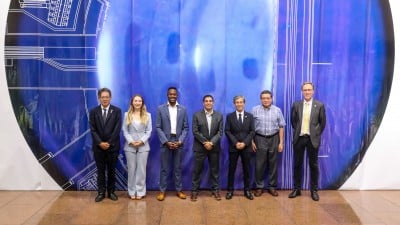Science
American Technology Powers World’s Largest Fusion Measurement System

The world’s largest superconducting fusion reactor, known as JT-60SA, will harness advanced measurement technology developed by the Princeton Plasma Physics Laboratory (PPPL) in the United States. This collaboration marks a significant milestone in the global effort to generate clean energy through nuclear fusion, as it represents one of the initial contributions from an institution outside of Japan and Europe.
Located in Naka, Japan, JT-60SA aims to advance fusion research by providing insights into plasma behavior, a critical component for achieving sustainable fusion reactions. The reactor is designed to explore high-performance plasma regimes, which are essential for future commercial fusion energy systems. The technology from PPPL will play a pivotal role in accurately measuring plasma characteristics, enabling researchers to optimize the fusion process.
The collaboration underscores the importance of international partnerships in the pursuit of fusion energy. Combining resources and expertise from various countries enhances the research capabilities necessary to tackle the complex challenges of fusion technology. With the support of the United States, the JT-60SA project is set to benefit from cutting-edge measurement instruments that will improve data collection and analysis.
PPPL’s contribution includes state-of-the-art diagnostic tools aimed at enhancing the understanding of plasma stability and confinement. These tools are vital for ensuring that fusion reactions can be sustained over extended periods. The project is expected to provide valuable data that could inform the design of future fusion reactors, including the international ITER project in France, which seeks to demonstrate the feasibility of fusion as a large-scale energy source.
The JT-60SA project, a collaboration between Japan and Europe, represents a significant step forward in the global fusion research landscape. As nations increasingly prioritize clean energy solutions, the advancements made at this facility will play a crucial role in shaping future energy policies and technologies. With the support of institutions like PPPL, the dream of harnessing fusion energy may move closer to reality.
The fusion research community views this partnership as a promising development. By integrating knowledge and resources from various sectors, researchers aim to accelerate the timeline for practical fusion energy. As the world faces pressing energy challenges, the successful implementation of JT-60SA could signal a new era in the quest for sustainable energy solutions.
This collaboration exemplifies how scientific progress often depends on collective efforts across borders. The fusion community is hopeful that innovations from projects like JT-60SA will pave the way for breakthroughs that ultimately contribute to a cleaner, more stable energy future for all.
-

 Lifestyle3 months ago
Lifestyle3 months agoLibraries Challenge Rising E-Book Costs Amid Growing Demand
-

 Sports3 months ago
Sports3 months agoTyreek Hill Responds to Tua Tagovailoa’s Comments on Team Dynamics
-

 Sports3 months ago
Sports3 months agoLiverpool Secures Agreement to Sign Young Striker Will Wright
-

 Lifestyle3 months ago
Lifestyle3 months agoSave Your Split Tomatoes: Expert Tips for Gardeners
-

 Lifestyle3 months ago
Lifestyle3 months agoPrincess Beatrice’s Daughter Athena Joins Siblings at London Parade
-

 World2 months ago
World2 months agoWinter Storms Lash New South Wales with Snow, Flood Risks
-

 Science3 months ago
Science3 months agoTrump Administration Moves to Repeal Key Climate Regulation
-

 Business3 months ago
Business3 months agoSoFi Technologies Shares Slip 2% Following Insider Stock Sale
-

 Science3 months ago
Science3 months agoNew Tool Reveals Link Between Horse Coat Condition and Parasites
-

 Science2 months ago
Science2 months agoSan Francisco Hosts Unique Contest to Identify “Performative Males”
-

 Sports3 months ago
Sports3 months agoElon Musk Sculpture Travels From Utah to Yosemite National Park
-

 Science3 months ago
Science3 months agoNew Study Confirms Humans Transported Stonehenge Bluestones









